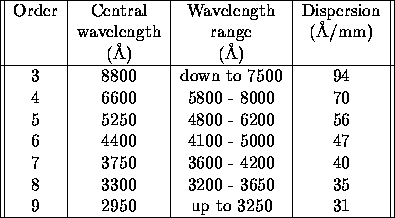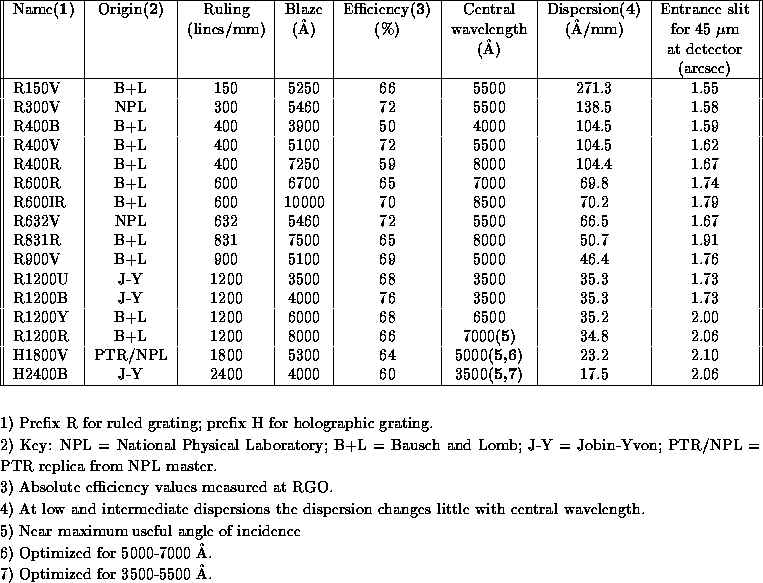 . The main
components are:
. The main
components are:




The layout of the IDS is shown in Figure  . The main
components are:
. The main
components are:
 m (0.216 arcsec) to 2 mm
(10.82 arcsec) in steps of 5
m (0.216 arcsec) to 2 mm
(10.82 arcsec) in steps of 5  m (0.027 arcsec). The entire slit
assembly can be removed, although operations staff must be made aware
of this requirement well in advance, as it is necessary to remove the IDS
from the telescope to do this.
Dekker masks are interchangeable
in sets; individual sets of 8 apertures and a clear position, can be made
up according to observing needs. Several standard dekkers, incorporating
single slots, pairs of slots, a ``comb'', and a coronographic set-up, are
always available. Detailed information can be found in a folder at the
Console Room of the INT.
m (0.027 arcsec). The entire slit
assembly can be removed, although operations staff must be made aware
of this requirement well in advance, as it is necessary to remove the IDS
from the telescope to do this.
Dekker masks are interchangeable
in sets; individual sets of 8 apertures and a clear position, can be made
up according to observing needs. Several standard dekkers, incorporating
single slots, pairs of slots, a ``comb'', and a coronographic set-up, are
always available. Detailed information can be found in a folder at the
Console Room of the INT.
 ), there are 2
below-slit filter slides, each of which has 3 colour or ND filter
positions. One of
these positions is always clear. Five colour filters are currently
available: UG11, BG18, BG24 and BG38, measuring
19 mm
), there are 2
below-slit filter slides, each of which has 3 colour or ND filter
positions. One of
these positions is always clear. Five colour filters are currently
available: UG11, BG18, BG24 and BG38, measuring
19 mm  60 mm
60 mm  2 mm and made from Schott glass, plus a
25 mm x 25 mm solid copper-sulphate crystal filter.
The wavelength dependence of the
transmission of these filters is shown in Appendix
2 mm and made from Schott glass, plus a
25 mm x 25 mm solid copper-sulphate crystal filter.
The wavelength dependence of the
transmission of these filters is shown in Appendix  .
The copper sulphate
filter cuts out the red part of the spectrum from 600 -- 650 nm upwards.
Its is usually used to cut out the first order FOS-1 spectrum, or the
red leak of the UG11 filter. The neutral density filters
below the slit provide a choice of ND = 0.5, 1.0 and 1.5.
Note that the use of filters below the slit may make it necessary to
refocus the spectrograph.
.
The copper sulphate
filter cuts out the red part of the spectrum from 600 -- 650 nm upwards.
Its is usually used to cut out the first order FOS-1 spectrum, or the
red leak of the UG11 filter. The neutral density filters
below the slit provide a choice of ND = 0.5, 1.0 and 1.5.
Note that the use of filters below the slit may make it necessary to
refocus the spectrograph.
 and
blazed at 4800 Å, can be inserted into the collimated beam in the
235 mm camera to provide a cross-dispersion option. This is normally
used in conjunction with an R150 echelle grating, which is blazed at
roughly 3
and
blazed at 4800 Å, can be inserted into the collimated beam in the
235 mm camera to provide a cross-dispersion option. This is normally
used in conjunction with an R150 echelle grating, which is blazed at
roughly 3  m. The FOS-1 dekker mask is used to limit the slitlength
to 25
arcsec in order to avoid order confusion.
The wavelength range and dispersion provided by this grating in each
order, for a grating angle of 62, are summarised in Table
m. The FOS-1 dekker mask is used to limit the slitlength
to 25
arcsec in order to avoid order confusion.
The wavelength range and dispersion provided by this grating in each
order, for a grating angle of 62, are summarised in Table
 .
.

Table: Characteristics of the IDS echelle grating
 128 mm.
A wide selection is available, and some of the important characteristics of
each grating are summarised in Tables
128 mm.
A wide selection is available, and some of the important characteristics of
each grating are summarised in Tables  and
and  .
Grating changes
can be made during the night by support staff.
.
Grating changes
can be made during the night by support staff.

Table: Characteristics of the IDS gratings with the 235 mm camera

Table: Characteristics of the IDS gratings with the 500 mm camera
Along the direction of the slit (i.e. perpendicular to the dispersion direction), the focal lengths of 235 and 500 mm imply slit to detector reduction factors of 5.43 and 2.55 respectively, and hence scales at the detector of 29.4 and 13.8 arcsec/mm.
Along the dispersion direction, the slit to detector reduction factor
is more complicated, since it depends on the grating angle. Tables
 and
and  give the slit width in arcsec which projects to 45 microns at the
detector, when each grating is used at its central wavelength.
give the slit width in arcsec which projects to 45 microns at the
detector, when each grating is used at its central wavelength.
The same tables also list the dispersion provided by each grating and camera combination. It can be seen that a wide range of dispersions is available, from 7 to 270 Å/mm.
 1152 pixels, pixel size
22.5
1152 pixels, pixel size
22.5 22.5
22.5 m,
a thinned Tektronix, image frame size 1024
m,
a thinned Tektronix, image frame size 1024 1024, pixel size
24
1024, pixel size
24 24
24 m or a thinned GEC, image frame size 385
m or a thinned GEC, image frame size 385 578, pixel
size 22
578, pixel
size 22 22
22 m. Spectral response curves and other details of the
available chips have been published in Gemini, June 1992, 36, p. 23.
Changing the detector on a particular camera can only be carried out during the
day. It is possible however, to have one CCD set up on one camera and another
CCD on the other, and operate the two systems consecutively during the same
night. Switching from one camera to the other only requires the grating to be
rotated (or exchanged), an operation normally carried out by support staff, and
the control software to be reinitialized.
m. Spectral response curves and other details of the
available chips have been published in Gemini, June 1992, 36, p. 23.
Changing the detector on a particular camera can only be carried out during the
day. It is possible however, to have one CCD set up on one camera and another
CCD on the other, and operate the two systems consecutively during the same
night. Switching from one camera to the other only requires the grating to be
rotated (or exchanged), an operation normally carried out by support staff, and
the control software to be reinitialized.



